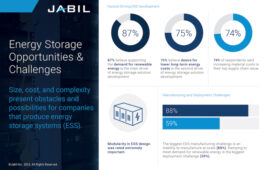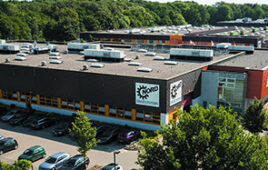By Sol Jacobs, Tadiran Batteries
A new type of rechargeable lithium-ion battery delivers reliable, long-term power for remote wireless devices powered by energy harvesting.
If a self-powered wireless device is intended for use in a remote location, and exposed to extreme environmental conditions, it is essential to choose the right power management system. This decision takes on even greater importance if the application is mission critical to avoid a power failure that could endanger lives or compromise vital data.
For the vast majority of remote wireless applications, the preferred choice for self-contained power is bobbin-type lithium thionyl chloride (LiSOCL2) batteries. Bobbin-type LiSOCL2 chemistry is preferred for long-term in extreme environments due to its high energy density, wide temperature range, and low annual self-discharge rate. Bobbin-type LiSOCL2 batteries have a proven track record in remote wireless applications, including batteries that are still operational after 28+ years in the field, capable of operating 40+ years without battery replacement.
However, advances in wireless sensor technology and the emergence of low power communications protocols have led to an explosion of applications that can be powered by either bobbin-type LiSOCL2 batteries or by energy harvesting devices working in tandem with rechargeable lithium batteries that store the harvested energy. Potential applications include measurement and control, factory automation, tire pressure monitoring systems, tank level monitoring, medical equipment and patient monitoring systems, and other M2M applications.
The emergence of energy harvesting
The emergence of energy harvesting technology is closely linked to the development of low power communications protocols such as ZigBee, Green Power, Bluetooth LE and 6LowPan. These low power protocols enable certain wireless sensor networks to operate within a peak power range of 10 µW to 100 mW, which is the sweet spot for energy harvesting devices that draw energy from a variety of sources, including light, heat, RF/EM, motion, or vibration.
Energy harvesting technology is rapidly evolving, and each different type of energy harvesting technology presents unique performance advantages and disadvantages, so due diligence is needed to specify the correct power management solution based on application-specific requirements, especially when high reliability is a concern.
There are five basic components to an energy harvesting device: sensor; transducer; energy processor; microcontroller; and transmitter if required. The sensor detects and quantifies environmental parameters such as temperature, humidity, motion, proximity, pressure, light, strain, vibration, pH, and so on. The transducer and energy processor work in tandem to convert, collect, store and deliver the electrical energy to the microcontroller and to the transmitter, if required, which process, analyze and transmit data to a host receiver or data collection point on either a continuous, periodic, or episodic basis. Energy harvesting devices are typically coupled with rechargeable lithium batteries that store the harvested energy. While consumer-grade rechargeable lithium-ion batteries have improved dramatically in recent years, these standard rechargeable lithium-ion cells still have inherent drawbacks for remote wireless applications, including short operating life (maximum 5 years), low maximum cycle life (1,000 cycles), high annual self-discharge (up to 60% per year), and limited temperature range (0°C to 60°C) with no possibility of charging at low and high temperatures.
To address the limitations of consumer-grade rechargeable lithium batteries, Tadiran recently introduced TLI Series batteries that use the same technology found in its hybrid layer capacitor (HLC), which stores the high current pulses required for wireless communications, and has been field-proven in millions of cells to deliver up to 40-year service life. TLI Series batteries modify this technology to deliver reliable, long-term performance under extreme environmental conditions.
TLI Series batteries offer unique performance features, including: the ability to deliver high current pulses (up to 15 A for AA cell); low annual self-discharge rate (less than 5%); up to 5 times more life cycles (5,000 full cycles); long operating life (20 years); wider operating temperature (-40°C to 85°C, with storage up to 90°C); charging possible at extreme temperatures (-40°C to 85°C); and a glass-to-metal seal. Available in AA and AAA diameters and custom battery packs, TLI Series batteries can be recharged using DC power or by energy harvesting devices.

TLI Series batteries, from Tadiran Batteries, use the same technology found in hybrid layer capacitors (HLC). But these batteries modify this technology to deliver reliable, long-term performance under extreme environmental conditions. They can deliver current pulses (up to 15 A for AA cell); have a low annual self-discharge rate (less than 5%); and a long operating life (20 years).
Real-life examples:
Here are a few examples that illustrate typical situations where remote wireless devices can be powered by energy harvesting devices supported by lithium-ion rechargeable batteries.
Logimesh manufactures wireless sensors that monitor the engines used to drive natural gas production compressors, using energy harvested from the vibration generated by these compressors to offer a self-contained power management system. Logimesh sensors detect real-time vibration and exhaust temperatures, monitor the operation of individual cylinder valves and produce valuable data that helps ensure safe operation and generates predictive models for long-term maintenance. Since natural gas compressors are often located in pipelines found in deserts and other inhospitable environments, a more rugged rechargeable lithium-ion battery was required instead of a standard consumer-grade battery.
The IPS Group manufactures solar-powered, wirelessly networked parking meters that use TLI Series rechargeable lithium-ion batteries for energy storage and emergency back-up power requirements. These innovative parking meters incorporate multiple payment system options, access to real-time data, integration to vehicle detection sensors, user guidance and enforcement modules, all linked to a comprehensive web-based management system. TLI Series rechargeable lithium-ion batteries suit this application in part due to their ability to deliver high pulses as well as to operate continuously at extreme temperatures of-40°C to 85°C, ensuring many years of maintenance-free 24/7/365 system reliability.

Energy harvesting technology is rapidly evolving. Solar-powered, wirelessly networked parking meters can use TLI Series rechargeable lithium-ion batteries for energy storage and emergency back-up power requirements. These innovative parking meters incorporate multiple payment system options, access to real-time data, integration to vehicle detection sensors, user guidance and enforcement modules, all linked to a comprehensive web-based management system.
Powercast designs and develops wireless devices and wireless sensor networks for low-power applications, employing both energy harvesting and LiSOCL2 battery technologies.
In one instance, Powercast developed a sensor that runs on RF energy harvested from broadcast radio or television signals, and RF transmitters located within 45 feet of the wireless sensor, a solution that was viable because the particular sensor required micro amps of power to operate, well suited to the RF energy sources that were nearby.
However, for a different application, the WSN-1101 wall-mounted sensor, Powercast chose to power the device with a hybrid LiSOCL2 battery instead of using energy harvesting.
The WSN-1101 wall-mounted sensor measures a variety of parameters, including indoor temperature, humidity and other variables in HVAC, lighting control, energy management, industrial monitoring, and medical applications. Designed for indoor use in temperatures ranging from -20°C to +50°C, the WSN-1101 can transmit data once per minute for more than 25 years to the Powercast WSG-101 wireless gateway, which interfaces with wired Building Automation Systems (BAS) networks via industry-standard protocols.

The WSN-1101 wall-mounted sensor measures a variety of parameters, including indoor temperature, humidity and other variables in lighting control, energy management, industrial monitoring, and medical applications. The customer chose to power the device with a hybrid LiSOCL2 battery instead of using energy harvesting.
Use of a long-life LiSOCL2 battery enables Powercast to offer a cost effective and reliable 25-year solution that instantly converts any building into a smart building, offering an upgrade for older structures with concrete or cinder block walls that cannot be easily retrofit for hard-wired solutions.
These examples demonstrate the exciting possibilities presented by energy harvesting devices supported by lithium-ion rechargeable batteries, as well as the continued use of bobbin-type LiSOCL2 batteries, providing a dynamic set of options for powering remote wireless devices.
Tadiran Batteries
www.tadiranbat.com
Filed Under: Energy management + harvesting





Tell Us What You Think!